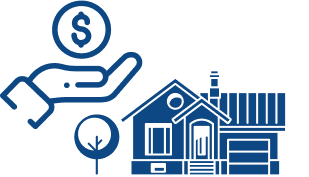Selling a House As-Is vs. Fixing It Up: Which Option Makes Sense for California Sellers?
November 13th, 2025 / Author: Cesar GomezSelling a house is rarely simple. In California, one of the biggest questions homeowners face is this: should you sell your house as-is, or fix it up before listing? This decision can shape everything - how much you earn, how long it takes to sell, and who your buyers are.
Let’s break it all down so you can figure out what really makes sense for your home sale.
Sell House As-Is or Fix Up: What Does It Actually Mean?
Before choosing a side, it’s important to understand what these two paths involve. Each one has its own style, timeline, and expectations.
Selling a house as-is means listing it in its current condition. No repairs, no touch-ups, no upgrades. You tell buyers what they’re getting, and they accept the property just like it is. That includes the good, the bad, and the outdated kitchen from 1984.
Fixing up, on the other hand, means making repairs or improvements before putting your home on the market. These can range from a basic coat of paint and cleaning up the yard, to a full kitchen remodel or replacing the roof.
Many California sellers lean toward fixing up because buyers are picky - especially with high home prices and limited budgets after closing. Others want to sell a house fast and avoid dealing with contractors. Both options can work - it just depends on your situation.
Why Some Sellers Choose One Over the Other
Homeowners across California pick different strategies for different reasons. It often comes down to what’s going on in their lives, their budget, and the property condition.
When Selling As-Is Makes Sense
Sometimes, it’s just not realistic to start painting walls or replacing floors. Here’s when people tend to go the as-is route:
- The home needs major repairs they can’t afford
- They’re on a tight timeline (relocation, job change, foreclosure)
- It’s an inherited property they don’t want to renovate
- They’re dealing with emotional stress, divorce, or illness
- They want to sell quickly to a cash home buyer
In many of these cases, sellers just want a clean break. Fixing the place isn’t worth the hassle.
Why Others Invest in Repairs
Plenty of California sellers choose to fix up their homes first, especially when they have the time, budget, and energy to handle the process.
They’re often trying to:
- Raise their listing price
- Attract regular House Buyers who need financing
- Get through inspections more smoothly
- Compete with upgraded homes nearby
Sometimes, a few affordable updates can make a huge difference in how buyers respond to a property.
What Smart Sellers Do Before Deciding
This isn’t a decision to make on gut feeling. California’s market conditions change quickly, and what made sense last year might not work today.
So, when it comes to selling a house in California, smart sellers take a few key steps to figure out which path - selling a house as-is or fixing it up - makes the most sense for their situation.
Get a Market Analysis
A comparative market analysis (CMA) from a local agent lays everything out clearly:
- What updated homes in your neighborhood are actually selling for - not just what they’re listed at
- How long properties are staying on the market based on their condition
- What kinds of buyers are active nearby - families looking for move-in ready or investors hunting for fixers
- What homes in poor shape are selling for compared to ones with recent upgrades
This gives you a realistic sense of your home’s current market value and helps you set expectations before deciding whether to sell as-is or invest in improvements.
Homes priced right from the beginning typically sell faster and avoid price drops. Listings that match their condition and location tend to move within 10-20 days in balanced markets, while overpriced homes can sit for 45 days or more.

Do a Pre-Listing Inspection
A pre-listing inspection gives you the full picture before buyers show up. It flags the things you don’t see - roof issues, plumbing leaks, electrical code violations. In California, these can run into the thousands if discovered later in escrow.
Sellers who know the condition of the home up front are in a stronger position to price it realistically or choose what to fix first. It also helps avoid last-minute surprises that delay or kill deals.
Get Repair Estimates
Even if you don’t plan to fix anything, it’s smart to know what bigger home repairs would cost. Roof replacement in California often runs $8,000-$15,000. New HVAC systems can land in the $9,000-$12,000 range. Foundation repairs might reach $20,000.
Having estimates in hand will help you justify a lower price if buyers push back, or decide whether it’s worth tackling certain fixes for better offers. It also signals that you’re prepared and transparent.
Talk to a Cash Buyer (Just to Compare)
You don’t have to accept an offer, but meeting with a few local cash buyers gives you real-world numbers. They’ll typically offer 70-80% of your home’s market value after subtracting estimated repair costs and their profit margin.
Even if the offer feels low, it gives you a baseline to compare with traditional market listings. For homes needing major work or fast timelines, this can actually net more after skipping agent fees and holding costs.
If you’d like a real number to work with, we at SleeveUp Homes can give you a no-obligation cash offer within days. You’ll see exactly what selling as-is could look like without listings, showings, or repairs.
If You’re Leaning Toward As-Is: What You Need to Know
If selling as-is sounds like the better option for you, there are a few things to be aware of. You can’t just list it and walk away.
You Still Have to Disclose Everything
California law requires full seller disclosure - even in an as-is sale. That means telling buyers about any known defects, damage, or problems with the house. This includes:
- Roof leaks
- Termite issues
- Plumbing or electrical problems
- Code violations
Sellers must fill out the Transfer Disclosure Statement (TDS), and buyers have the right to inspect the home. Hiding issues can lead to lawsuits later.
Cash Buyers Are Usually Your Audience
Most traditional buyers want a move-in-ready house. Homes sold as-is usually attract:
- Real estate investors
- Flippers
- Cash home buyers
- DIY-savvy buyers looking for a deal
These buyers know what they’re doing - but they also expect a deep discount to make the deal worth it. In California markets where the median home price exceeds $700,000, that could mean leaving $100,000 or more on the table.
And all-cash transactions aren’t rare - around 30% of repeat buyers now purchase homes outright. That’s a strong sign there’s still healthy demand for as-is properties, especially among buyers who want to close fast and skip loan approvals.
If you’d rather skip repairs and long negotiations, SleeveUp Homes can make things simple. We buy homes across California as-is for cash, handle the closing costs, and take care of all the paperwork. You can expect a quick property review, a fair offer within days, and a closing date that fits your schedule - no matter if that’s next week or next month.
It’s an easy way to sell without the uncertainty of the traditional market!
Financing Could Be a Problem
If your house has major defects (like no working heat or unsafe wiring), it might not qualify for a loan. That limits your buyer pool to cash buyers or those using rehab loans. FHA and VA loans in particular have strict condition standards.
Pricing Has to Reflect Condition
The most common mistake with as-is listings? Pricing too high.
You’ll need to discount needed home repairs - sometimes by tens of thousands. Buyers will do the math and subtract it from your asking price, along with extra for their risk. In competitive markets, overpriced as-is homes sit for weeks while updated homes sell within days.
Overpricing an as-is home doesn’t just stall the sale - it can actually lower your final selling price after price drops and lowball offers.
If You’re Leaning Toward Fixing Up: Do It With a Plan
Fixing your home before selling can bring higher offers, but only if it’s done strategically. Some sellers jump straight into renovations without checking the latest market conditions and end up spending more than they’ll ever get back.
Others choose small, targeted updates that make buyers fall in love the moment they walk in.
The key is to think like a buyer, not like a designer. Most buyers care more about the condition, layout, and light than fancy finishes. Clean, functional, and well-maintained almost always wins over high-end upgrades done for the wrong crowd.
It’s not just about looks, but about smart spending that gives the best return on investment when you finally list the home.
Focus on the Areas Buyers Notice First
Buyers often make up their minds within seconds of walking in - or even before, based on listing photos. That’s why first impressions are everything. In California’s competitive real estate market, the right visual cues matter.
The three most important zones are:
- Curb appeal: Fresh paint, tidy landscaping, and a clean front door can raise perceived value instantly.
- Kitchen: Even minor kitchen remodels - updated hardware, lighting, and painted cabinets - can return over a big portion of their cost in resale value.
- Bathrooms: Re-grouting, new mirrors, and clean tile go a long way. A bathroom that feels hygienic and modern signals a “move-in-ready” home.
You don’t have to go luxury. A bright, neutral, clean kitchen or bathroom feels safe to buyers. They can picture themselves living there - and that emotional connection drives offers.
Check the Basics Before the Cosmetics
Nothing kills a deal faster than beautiful finishes hiding mechanical problems. Before you spend a dime on decor, make sure the home’s fundamentals are solid:
- Roof lifespan and condition
- Electrical panel safety
- Plumbing leaks or corrosion
- HVAC system performance
- Foundation cracks or settling
These are non-negotiables for most buyers and home inspectors. If something big fails, you’ll either lose the sale or end up repairing it later under pressure.
Use a Pre-Listing Budget
Set a ceiling for how much you’ll spend.
A smart rule: invest only what you can realistically recover, ideally 1-3% of your home’s value. So if your home could sell for $800,000, a $10,000-$20,000 refresh might be plenty.
If you’re unsure, a real estate agent or stager can walk through your house and tell you where your money makes the most impact. They see hundreds of buyer reactions each year - trust their instincts over a contractor’s pitch.

Common Mistakes California Sellers Make (and How to Avoid Them)
Selling a house, as-is or freshly renovated, can go wrong fast when sellers skip planning or make emotional decisions. Here are some of the biggest pitfalls seen across California’s real estate market - and how to stay clear of them.
1. Misreading Buyer Psychology
A home sale isn’t just about math - it’s also about emotion. Sellers often assume buyers think logically, but they don’t. Even “as-is” buyers want a sense of opportunity, not neglect.
A house that feels forgotten (dark rooms, overgrown yard) discourages offers. Meanwhile, a slightly flawed home that’s clean, bright, and smells fresh can sell faster than one that’s technically in better shape. Presentation creates confidence - even in fixer markets.
2. Not Accounting for Holding Costs
While debating between fixing up or selling fast, many forget the cost of time. Every extra month adds mortgage payments, insurance, taxes, and utilities.
In California, the average holding cost for a $700,000 home can exceed $5,500 per month.
So, a three-month renovation delay could eat up $10,000 or more - often wiping out the profit from doing that “extra” project.
3. Assuming Cash Buyers Mean Quick Profit
Cash buyers simplify the process but rarely pay top dollar. Their offers factor in renovation costs and profit margins. Some sellers reject an early cash offer hoping for better - only to accept less later after months on market.
The smarter move is to treat cash offers as a benchmark, not a fallback. If your net proceeds after repair, agent fees, and time costs end up similar, the “lower” cash offer might actually win.
4. Forgetting the Appraisal Reality
If you’re selling to financed buyers, remember: appraisers don’t care about design trends. They base value on comparable homes and condition, not your choice of quartz counters.
Even with upgrades, appraisers cap value within the local price ceiling. So, for example, if the neighborhood’s top comp is $850,000, you won’t get $900,000 just because you spent $50,000 remodeling.
Many sellers over-improve past that ceiling - an easy way to lose ROI without realizing it.
5. Neglecting Energy Efficiency
California buyers increasingly ask about insulation, solar readiness, and electric upgrades. Even inexpensive touches - LED lighting, weather-sealing, or a smart thermostat - can make a listing stand out.
In many areas, homes with visible energy-efficient features sell faster and attract better-qualified buyers. Yet sellers still overlook this angle because they think it’s a luxury, not a basic selling point.
6. Rushing the Reveal
Some sellers finish renovations one week and list immediately, skipping professional cleaning, staging, or photography.
That’s a mistake - presentation is your “second renovation.” Homes photographed in bad light or clutter can lose thousands in perceived value online. Taking just one extra week to stage, photograph, and market properly often results in 1-10% higher offers.
Choose the Smarter Path Forward with SleeveUp Homes
At the end of the day, the choice between selling a house as-is vs fixing up comes down to what matters most to you - time, effort, or return. Both paths can work beautifully when they match your situation.
If you’re unsure which fits your goals, that’s where we come in. At SleeveUp Homes, we buy California houses in any condition - no agents, no repairs, no commissions. We can also walk you through what your home might sell for on the open market, so you can compare options side by side.
Contact us for a no-obligation offer or free home analysis today - and take the next step toward selling your home on your own terms.
SELL
YOUR HOUSE
If you want to sell fast and are worried about how long the traditional process takes, and the commission and fees involved, consider working with SleeveUp Homes.





 view all blogs by this author
view all blogs by this author Zachariah Peterson (69 blogs)
Zachariah Peterson (69 blogs)